
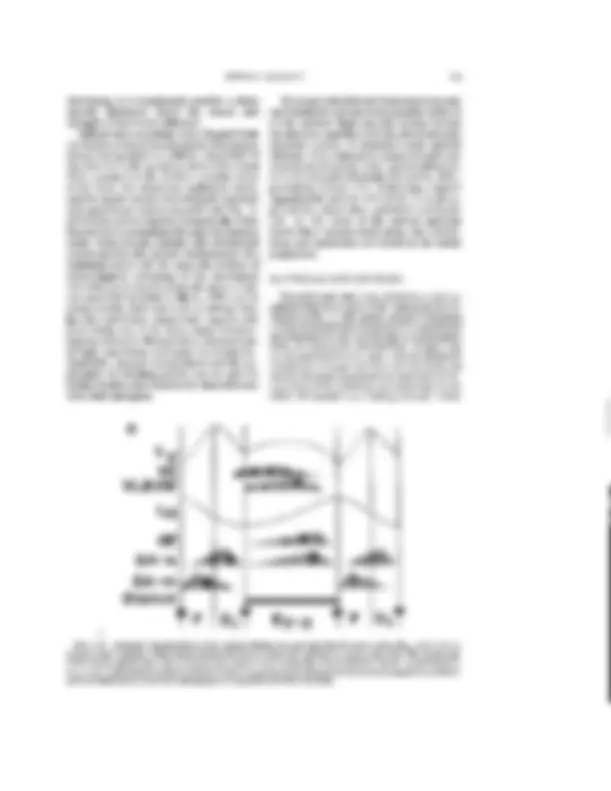
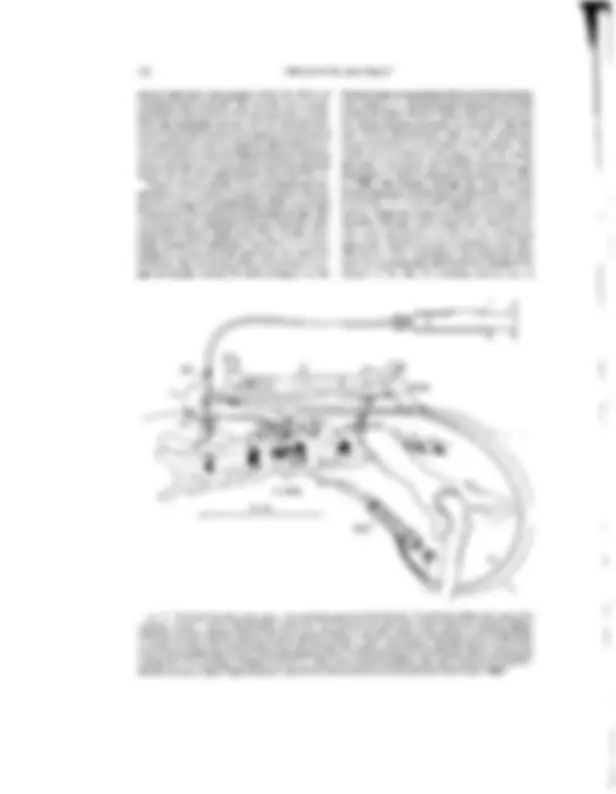
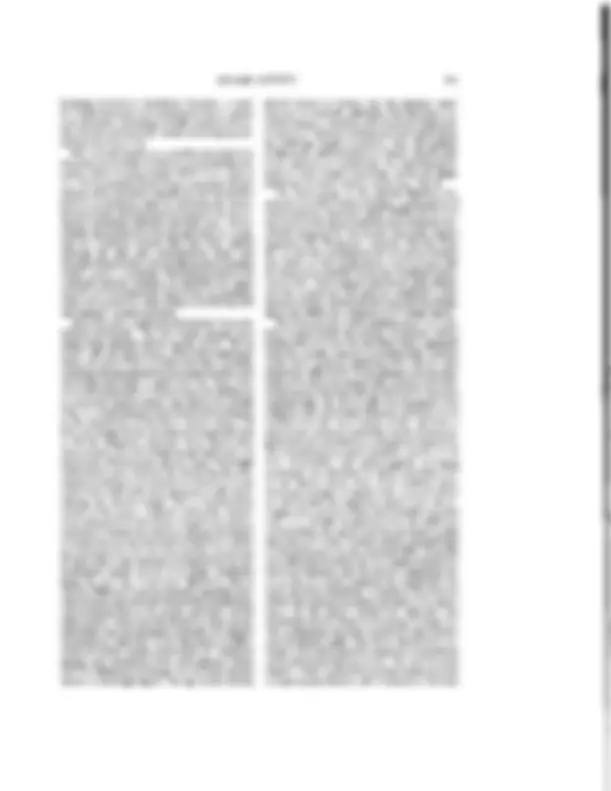

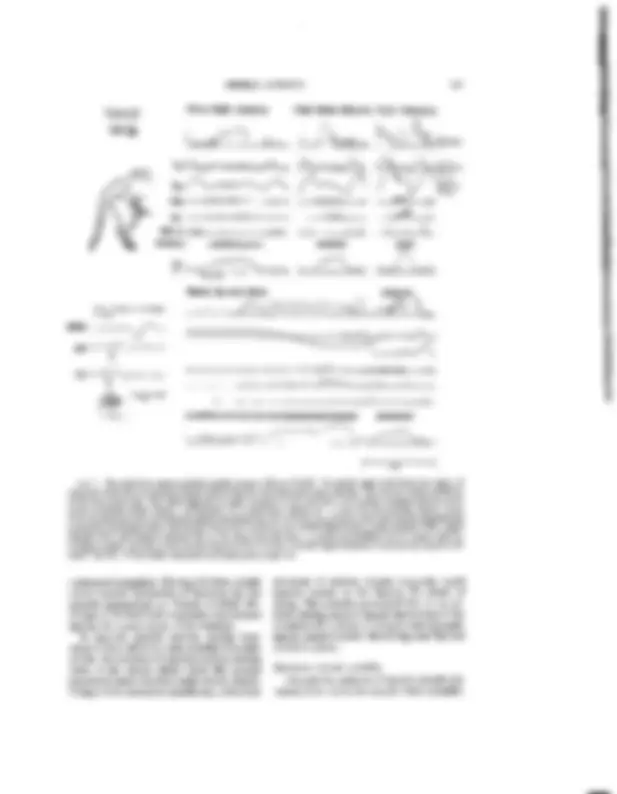
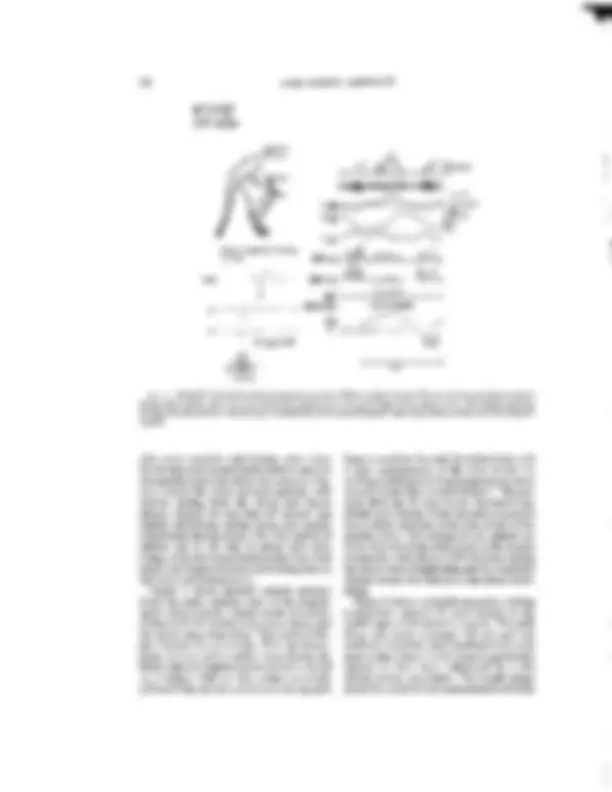
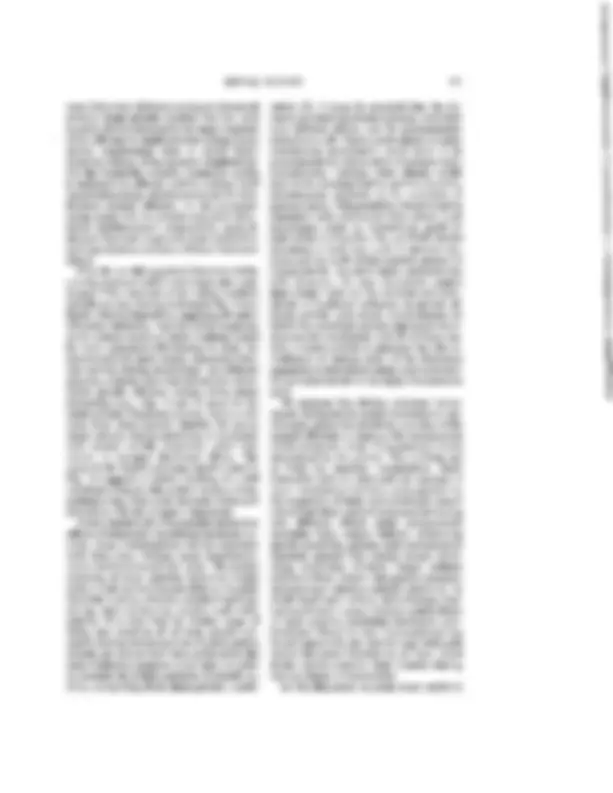




Study with the several resources on Docsity

Earn points by helping other students or get them with a premium plan


Prepare for your exams
Study with the several resources on Docsity

Earn points to download
Earn points by helping other students or get them with a premium plan
Community
Ask the community for help and clear up your study doubts
Discover the best universities in your country according to Docsity users
Free resources
Download our free guides on studying techniques, anxiety management strategies, and thesis advice from Docsity tutors
This document reports the results of a study on the activity patterns of muscle spindle afferents during unrestrained treadmill locomotion. The study used floating microelectrodes implanted in the fifth lumbar dorsal root ganglion to record the activity from knee extensor and biarticular muscles acting across the knee and hip. The document also discusses the effects of changes in gait speed on muscle length excursions and spindle afferent activity, suggesting concurrent and compensatory changes in fusimotor influence on spindles.
What you will learn
Typology: Study notes
1 / 16

This page cannot be seen from the preview
Don't miss anything!










JOURNALOF NEUROPHYSIOLOGY Vol. 54. No. 3. September 1985. Prinled in U.S.A.
S U M M A R Y A N D CONCLUSIONS (^) 6. Activity from spindle secondary endings
subserving local motor control circuits, as well
see Refs. 7, 29).
FIG. I. A: innervation of the anterior thigh muscles of the cat and the relationship to the instrumentation implanted for these studies. DRG, array of up to 12 individual metal microelectrodes implanted in the 5th lumbar dorsal root
electrode configuration in the distal half of the femoral nerve CURSaph. n. and Hamst. n., bipolar nerve cuffs used for stimulation experiments reported elsewhere (25); SA-a, bipolar EMG patch electrode on anterior part of sartorius muscle; SA-m, bipolar patch electrode on medial sartorius; RF, multipolar EMG spiral electrode in rectus femoris muscle; VM, spiral electrode in vastus medialis muscle; VI, spiral electrode in vastus intermedius muscle; VL, spiral electrode in vastus lateralis muscle; LV,length gauge across vastus muscles (knee joint only); LR, length gauge across rectus femoris and anterior sartorius muscles (knee and hip joints); Fp, strain gauge mounted on patellar ligament.
several days after each surgery when the effects of anesthesia had worn off. Unit records were usually obtained in the second to fifth postoperative weeks. Both the implanted devices and the external con- nector were well tolerated throughout the course of the experiment, with no apparent discomfort o r ir- ritation either during recording sessions or between them, although some animals favored the operated leg for the first few postoperative days (see Fig. 5).
plantation and fixation technique together with the general strategy for maintaining a stable, long-term connection to the numerous implanted devices. The microelectrodes consisted of 50-pm diameter, plat- inum-20% iridium shafts with Pyre Tri-ML poly- imide insulation (California Fine Wire Co.) cross- welded to 25-pm diameter gold lead-out wires for flexibility. The recording surface was formed a t sur- gery by simply cutting the shaft obliquely to the
desired length using scissors. Each gold lead, in turn, was welded to a multistranded stainless steel lead anchored within silicone rubber tubes mounted on the dorsal spinous processes, to provide a flexible and strong percutaneous lead to the connector mounted outside on the back of the animal. The welds were reinforced with epoxy, and the entire assembly overcoated with Parylene insulation, the deposition of which is detailed elsewhere (2 1). The
dorsal dissection of soft tissues followed by a small
lamina. These electrodes were inserted by hand into
ceps with tips ground to receive the reinforcing epoxy ball. Typical electrode impedances were 100-
prior to recording and proved to be a sensitive in- dicator of the loss of recording sources due to
FIG. 2. Detail of microelectrode, nerve cuff, and back-pack connector fixation. The silicone rubber tube array (TA) mounted on the L, and L6 dorsal spines carries the joint between the gold leads of the dorsal root ganglion (DRG) electrodes and the stranded, stainless steel percutaneous leads (L) that are soldered to the printed circuit boafd (PCB) mounted as a back pack via anchoring sutures (AS) through the L4and L, dorsal spines. The femoral nerve cuff (FNC) carries five circumferential contacts whose percutaneous leads (L) terminate similarly on PCB along with an intraluminal catheter (IC). For recordings, multipin connector C mates with a connecting ribbon cable and 12-channel preamplifier; between sessions, a light-weight aluminum cap protects the percutaneous leads and joints from being snagged.
The transformer-coupled amplifier system (1- 10
Anatomical and functional organization of the muscles
The anterior thigh muscles of the cat, al-
Spindle aferents identified Table I gives the coded name and putative
such an error in-the classification of parent muscle would not affect the interpretation of the spindle activity. A similar consideration applies to the distinction between SA-a and RF, although the more superficial SA-a muscle provided a better subject for vibratory local- ization of the receptor. A couple of units re- sponded well to passive hip motion but only weakly to knee motion; these presumably came from the intermediate region of the SA muscle, which attaches to the medial edge of the patellar ligament, and hence has no exten- sor or flexoraction on the knee. From the conduction velocities, it is appar- ent that our method of recording was biased toward the larger, faster fibers, as noted pre- viously (20). In addition to the usual biases of extracellular recording electrodes, it is possible that many group I1 units with conduction ve- locities slower than 72 m/s were recorded but not identified as passing through the femoral nerve cuff. This is because the amplitude of the extracellular action potential decreases as a power function of decreasing fiber diameter (12, 27), and signal-to-noise increases as the square root of the number of averaged sweeps.
TABLE 1. Spindle afferents recorded and identified
CV, Vib., Gamma ID# Muscle m/s Hz Block Ref.
J6AlO VM 115 200 X K12A9 VM 33 NS L3A29 SA-a 121 320 X 23 N5A6 SA-a 119 300 X 23, N6A15 SA/RF 103 N D N6A27 SA-m 94 210 X 10, OlOA6 SA-a 120 250 X 25 S9A12 SA-m 65 NS X T9B6 VM 109 220 X 23 T12A8 VL 109 330 X 23, 25 T3A15 SA/RF 100 N D T9A17 SA-m 98 220 X 23 T9A22 VM 1 1 1^400 X^^23 T2B8 V? 45 N D
NS, not sensitive; ND, not determined; CV, conduction velocity; Vib., vibration.
Proprioceptive units with hip and/or knee motion sensitivity were frequently recorded without such averages being obtainable even with 4,000 sweeps; these were all rejected as potentially arising from noninstrumented muscles such as tensor fascia lata. In addition to the figures published here, Table 1 lists references where we have pub- lished records of activity of other anterior thigh spindle afferents, usually for conditions other than unperturbed locomotion.
Vasti muscle spindles Figure 3 shows activity from a spindle pn- mary afferent typical of those identified as arising from the pure knee extensor vasti group. During the extrafusal muscle activity of the stance phase, the spindle activity was modulated between -50 and 200 pps, with a clear tendency to increase its rate in response to a combination of both amplitude and rate of stretch. At the slower walking speeds, the swing phase activity was much lower despite larger and faster stretching of the passive mus- cle during the flexion phase than during stance. At the fast trot speed, the even larger, faster flexion movements began to cause more spin- dle activity than that seen during the nearly isometric stance phase. Spindle activity was generally quite low or zero during muscle shortening in both swing and stance (although it was occasionally maintained at significant levels through the end-stance extension; see fast walk and end of first stance phase in lower set of traces). The muscle velocities were gen- erally in the range of? 1 rest lengthis, but be- cause of the high angle of pinnation and rel- atively short muscle fibers (-2 cm; Ref. 3 3 , the velocities experienced by muscle fibers and parallel structures such as the muscle spindles were probably closer to four times that value (if expressed as fiber lengths/s). The sequence of events at the bottom of Fig. 3 gives some indication that the pattern of discharge observed during walking was not caused by the transducer properties of a passive spindle lacking in fusimotor drive. At the be- ginning of the trace, the animal was sitting with the knee highly flexed, maximally stretching the vasti muscles but causing only low-frequency, irregular afferent activity. As the animal built up muscle tone in preparation for extending the knee and standing, the ac- tivity of the afferent rose dramatically but
medial
Spike Triggerea Average n-
Fp A -. Stance~ -
FIG. 4. Records from anterior sartoriusspindle primary 010A6, sensitiveto knee flexion and hip extension as shown in the insert sketch, with 120 m/s conduction velocity from the spike-triggered average at lower left. (Slight phase lag of electronically derived velocity trace is artifactual.) Raw microelectrode recording is shown under the unit frequen- cygram.
ably more complex and diverse, even when the division into anatomically distinct anterior and medial parts was taken into account. Fig- ure 4 shows the most common pattern, with activity during both the swing and stance phases, despite the fact that the muscle was rapidly shortening during swing and rapidly lengthening during stance. The only period of silence was at the end of stance and early swing, when the niuscle had reached maximal length and began passively shortening prior to the active shortening in E,. Figure 5 shows another spindle primary from the same anterior part of the muscle, again with generally similar levels of activity during both the lengthening stance phase and the shortening swing phase. This unit is of fur- ther interest for two reasons. First, the stance- phase activity had a sudden drop during the fastest rates of lengthening (see arrow in record A), a feature that we have noted previously (18) and that was not uncommon during such
large excursions. Second, the animal was only 6 days postoperative at the time of this re- cording and began to limp progressively more severely in the later records Band C. The pos- tural shift can be seen in the decreased am- plitude and velocity of the hip joint excursions and a subtle decrease in the rate of rise of the patellar force. The changes in the spindle ac- tivity were much less than those in the muscle excursions, with about a 50% decrease during the stance phase lengthening and no consistent change during the reduced swing phase short- ening. Figure 6 shows a spindle secondary ending (conduction velocity 65 m/s) located in the medial part of the sartorius muscle. The peak firing rate rarely exceeded 100 pps and was relatively smoothly modulated (perhaps even more so than shown in the frequencygram that appears to have been influenced by a few missed action potentials). The length gauge across the rectus femoris and anterior sartorius
N5A SA-a I a medial
Spike Triggered Averege n-
Walking with Limp A B
FD ---\I"-----
I ,.oms I
Stance - - - T.................... 1 1 10m18 50cm18^ 3 5 c m l s^ 4Ocmla I (^) 1.08 I
FIG. 5. Records from anterior sartorius spindle primary N5A6, sensitive to knee flexion and hip extension, with 119 m/s conduction velocity. Relatively normal walking in A reverted to a limp in B and C with progressively less motion at the hip and knee as the animal (6 days postoperative) became tired. Arrow in A indicates pause possibly related to yielding of intrafusal structures.
S9A SA-m 11 Slow Walk-40cmls Fast Walk-80cmls
Lv v SA-m
HG. 6. Records from medial sartorius spindle secondary S9A12, sensitive to knee extension and hip flexion, with 65 m/s conduction velocity. See text for explanation of length traces.
some fusimotor influence acting on almost all anterior thigh spindles studied. For the vasti muscles, this is indicated by the larger response of the afferents to small stretches during stance (active lengthening) than to much larger stretches during swing (passive lengthening). For the biarticular muscles, fusimotor action is indicated by afferent activity during rapid muscle shortening, which is never seen in deef- ferented spindle afferents. In the accompa- nying paper (23) we present data from func- tional deefferentation experiments using li- docaine blockade to provide some qualitative and quantitative estimates of these fusimotor effects. How far can this apparent fusimotor influ- ence be dissected before resorting to pure con-
jecture? The responses of the vastus medialis spindle primary during walking in Fig. 3 were highly velocity dependent, suggesting dynamic fusimotor influence, but the initial sequence as the animal stood up before walking would be more consistent with biasing by static fu- simotor activity (note steady, somewhat irreg- ular activity during shortening). On different grounds, it seems clear that the activity of sar- torius spindle afferents during swing phase shortening (e.g., Figs. 4 and 5) must be the result of static fusimotor activity, but it is not clear from these records whether the stance phase activity during stretching is consistent with passive spindle properties, static fusi- motor, or dynamic fusimotor effects. The pause in the middle of a large stretch noted in Fig. 5A suggests a sudden yielding of a stiff intrafusal element with a slow recovery time, perhaps a bag, fiber under dynamic fusimotor activation, but this is again conjectural. If one considers all of the possible interactive effects of temporally modulated fusimotor ac- tivity, many combinations will be consistent with these data. Perhaps more importantly, many combinations are not likely. The sudden silencing of most spindles following length peaks in late stance indicates little or no static fusimotor activity, whereas sustained discharge during rapid shortening requires such static activity. It is clear that the similar range of firing rate noted in all of these spindle pri- maries during various periods of active parent muscle use cannot have been achieved by the same fusimotor program in all cases. In order to interpret all of these patterns of spindle ac- tivity as resulting from alpha-gamma coacti-
vation (9), it must be assumed that the dy- namic and static fusimotor systems, with their very different effects, can be independently turned on or off. That is, some phases of alpha motoneuron recruitment would have to be accompanied by coactivation of gamma static motoneurons, whereas other phases would have to be accompanied by gamma dynamic motoneurons, probably to the exclusion of gamma statics. This possibility becomes more consistent with traditional ideas about fixed recruitment order in motoneuron pools in light of the finding that the two EMG bursts occurring in each step cycle in anterior sar- torius are the work of two separate groups of independently recruited alpha motoneurons (1 I). However, the two companion papers shed further light on the amount and com- plexity of fusimotor influence on spindle af- ferent activity and reveal circumstances in which the extrafusal activity appears to be in- dependently modulated. For all of these rea- sons, it seems unwise to presume that the re- cruitment of various parts of the fusimotor apparatus is determined simply and invariably by activation levels in the alpha motoneuron pool. We propose that during voluntary move- ments, the fusimotor system functions to con- tinuously adjust the sensitivity and bias of the spindle afferents to improve the transduction of the particular range of mechanical events anticipated by the animal. The evolving use of limbs for multiple, independent, finely controlled tasks in mammals (as opposed to lower vertebrates) has been accompanied by the separation of intra- and extrafusal control into at least three types of motoneurons having very different effects: alpha motoneurons modulate force output without influencing spindle sensitivity, gamma static motoneurons maintain spindle bias during muscle short- ening (extending dynamic range) without adding to force output, and gamma dynamic motoneurons enhance spindle sensitivity to small length and velocity perturbations (nar- rowing dynamic range). Various combinations of these systems (including hardwired com- binations offered by beta motoneurons) can be and apparently are used to cope with such varied kinematic behavior as we have noted in the various anterior thigh muscles during various phases of locomotion. In this discussion, it seems more useful to
562 LOEB, HOFFER, AND P R A n
take a broader view of the phenomenology of spindle afferent traffic and to consider its pos- sible interpretation by the spinal cord and the higher motor control structures that presum- ably rely on these signals to guide and refine their output decisions. In that context, the most striking general finding is that almost all of the spindle afferents from which we re- corded had similarly well-modulated activity during the periods of extrafusal activity of their parent muscles. Spike rates rarely exceeded -200 pps and rarely fell below 20-50 pps (somewhat lower for secondaries), although sustained low-frequency activity was a typical feature of these same muscle spindles when the animal was lying quietly or lightly anes- thetized with the limb at an intermediate an- gle. A similar tendency has been noted for spindles in a wide variety of muscles and mo- tor tasks (for review see Ref. 19). The sequence shown at the bottom of Fig. 3 was typical of the systematic biasing of activity that accom- panied the onset of locomotor activity in the anterior thigh muscles. In a perhaps related feature, the activity of these afferents changed very little with changes in the speed or extent
of the joint angle excursions and/or changes in parent muscle EMG during locomotion made by voluntary actions of the animal. This suggests that such voluntary changes in the extrafusal motor program were accompanied by compensatory changes in the intrafusal program, consistent with the servo-control notion of using sensory feedback to provide an error signal to the motor controller (see Ref. 36). All of this is consistent with a systematic optimization of instantaneous transducer sen- sitivity to make the best use of the informa- tion-conveying properties of an afferent data stream consisting of all-or-none action poten- tials propagating along an axon (for quanti- tative analysis, see Ref. 25a). Firing rates above 200 pps appear to be difficult to sustain; the rare instances of such rates in our own data (e.g., Figs. 4 and 5) and similar records in other muscles (22, 32, 33) appear intermittent and noisy, tending to degrade the information that can be extracted from the afferent signal. Fir- ing rates below 50 pps cannot signal instan- taneous changes in mechanical input simply because they must be integrated over at least their interpulse intervals (20 ms or longer) be- fore changes can be appreciated. The integra-
tion of many afferents by postsynaptic neurons solves this problem only at the expense of low signal-to-noise levels or degraded spatial res- olution (25a). If the central nervous system is interested in optimizing the sensitivity of its motor control apparatus to unexpected per- turbations in the limb trajectory (either short- ening or lengthening the muscle), it must do two things: 1)It must keep the spindle afferent firing rates within this window of optimal firing rates. 2) It must adjust afferent sensitivity so that the range of perturbations anticipated during the movement causes maximal mod- ulation of afferent discharge within this window. The different independent effects of the static and dynamic fusimotor neurons on spindle afferent dynamic range noted above are particularly well suited to these tasks, but only if the central nervous system has inde- pendent control of the various types of mo- toneurons. Such an interpretation of fusimotor activity suggests a specific division of labor between the primary and secondary endings. The same programming of the primary endings that might optimize instantaneous sensitivity to unexpected perturbations of limb trajectory can also be expected to greatly complicate the extraction of kinesthetic information about posture. Information about wide-ranging but slowly changing aspects of limb and trunk po- sition is probably an important output of the muscle spindles, in concert with joint and skin stretch receptors. The secondary endings, with their less rapidly modulated firing rates and more linear responses to length, might provide a better input signal to a central integrating circuit with relatively long time constant for keeping track of overall limb position. Of course, at least part of the fusimotor control system that influences the primary endings is shared with the secondaries (the chain fibers innervated primarily by gamma static moto- neurons). However, the transducer sensitivity effects of these fibers tend to improve rather than degrade linearity of the response to length changes by reducing velocity-dependenteffects (16) and extending the useful range of the transducer into the negative velocity (short- ening) regions (2). The spindle afferent activity studied here includes examples of muscles classified as ex- tensors (vasti and rectus fernoris) and as flexors
pace-makers operating in the cat muscIe spindle. Brain Res. 173: 21-28, 1979.
The Muscle Spindle. London: Macmillan. In press.
Physiological characterizationof motor unit properties in intact cats. J. Neurosci. Methods 7: 137- 149, 1983. 3 1. PHILI~PSON, M. L'Autonomie et la centralisationdans le systeme nerveux des animaux. Trav. Lab. Physiol. I u t. 7: 1-208, 1905.
D. G. The tendon organs of cat medial gastrocnemius: responses to active and passive forces as a function pf muscle length. J. Neurophysiol. 38: 1217-1231, 1975.